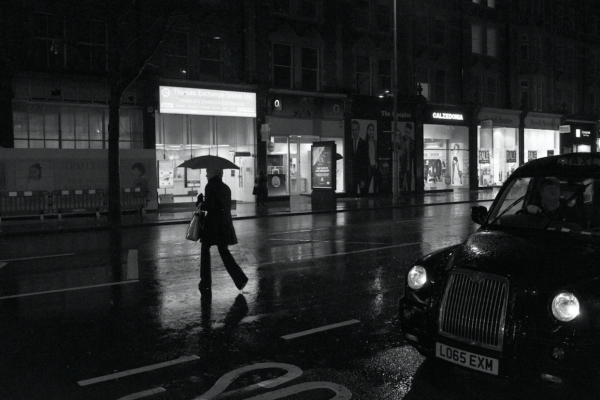FCLC Student Captures the Art Scene in London
Matthew Scheffler, FCLC ’18, has spent his time abroad capturing moments on the streets of London. (COURTESY OF MATTHEW SCHEFFLER).
April 10, 2017
London is a gorgeous city, a kind of elderly statesman amongst the metropolitan capitals of Western Europe. Amidst the old, winding cobblestone lanes of Camden Market or the glowing banks of the Thames, culture blooms everywhere—there is so much to see and experience. This makes my job as a street photographer a challenge but also a thrill. As in New York, the experience of photographing London boils down to observing life in an urban space; both cities are petri dishes teeming with diversity. Perhaps the most challenging aspect as a photographer is capturing the city in a way that isn’t cliché, but instead timeless, iconic and intimate. Black cabs and scarlet double-decker buses speed by in a blur of motion, color and sound. The city is visceral—a living being, pulsating to the mechanized whir of urban life. As a tourist, a visitor, it’s hard to blend in. Now I know how it feels to be gawked at when tourists in New York visit Times Square, for example (I myself have received a fair share of annoyed glances when trying to take a selfie in Trafalgar Square). The experience of being a temporary visitor makes the task of street photography that much harder, and getting accustomed to the way local Londoners think is an aspect of that challenge. Still, it remains that London is well-stocked in its art collections, galleries and museums; it’s a fantastic city for seeing art too.
Currently I am taking a course entitled “Art & Architecture in London,” which has served as an illuminating guide into the rich history of London’s 500-year-old art scene. Led by independent art historian Dr. Geoff Snell, students are encouraged to explore the vast and diverse selection of the city’s galleries, museums and historic sites. We are given a comprehensive view of British art history from royal portraiture in King Henry VIII’s court to the latest photography of Wolfgang Tillman. Every other week, students are not in the classroom, but on class outings to museums such as the Tate Britain, Victoria & Albert Museum and the British Museum. Integrating the streets of London, the course provides practical insight and firsthand knowledge, encouraging students to explore their own interests. Learning about Britain’s most important pieces of art, and then being able to actually see them in person has been the most exciting aspect of Fordham’s London Liberal Arts program.
When one thinks of titans in the history of art, England is seldom acknowledged; as history would have it, we remember Michelangelo, Leonardo Da Vinci, Monet, Van Gogh, Picasso. Yet my time in London thus far has, if anything, shed light on Britain’s significant contributions to the art community. The city is proud of its artistic culture and celebrates it on the walls of the National Gallery, for example, where one can relish the blurry beauty of J.M.W. Turner or the scathing moral criticisms of William Hogarth. However, my favorite art institution in London is the Tate. Comprised of two separate museums, the Tate Britain and the Tate Modern, the Tate offers an incomprehensibly extensive selection of British artists. This month, our entire class had the privilege of viewing David Hockney’s retrospective at Tate Britain which encapsulates over sixty years of Hockney’s career, from his early sketches to his most recent iPad drawings. Hockney is heralded as Britain’s most prolific and virtuosic painter of post World War II twentieth century.
But for the most part, seeing art in London is a very similar experience to seeing art in NYC. The Tate Modern is my favorite and is akin to New York’s own Museum of Modern Art, while the Tate Britain is perhaps something closer to a combination of The Met, Whitney and Frick Collection. If modern art isn’t your thing, I’d recommend the National Gallery or the British Museum; the latter chronicles the history of classic British art, while the former houses historic relics. Either way, stroll through (admission is free to most museums) and experience all facets of British art. The best way, I have found, is to walk the city — London is itself a kind of architectural gallery. Pass by landmarks new and old, for example, the Gherkin, a pickle-shaped office building designed by Foster and Partners, or The Queen’s House in Greenwich which is just outside the city proper. Despite the dreary, gray weather, the London art scene is never boring.













